Details for the HVAC system
|
This HVAC unit is designed for high efficiency and high performance heat management of electronic enclosures or equipment. This product is an active thermal management system with an internal refrigerant system and is designed for electronic environments. The unit is controlled with a control board that provides an easy to use interface to operate a Test Mode for startup and diagnosis, configure operating parameters for temperature and alarm set points, provide anti-short cycling, monitor operating pressure(s), provide visual alarms and diagnosis, and provides a HVAC trouble/temperature alarm dry contact output. |
 |
| Features: 12,000 BTU Cooling 1,000 W Evaporator Heater Condenser fan intake filter Ethernet controller with digital display |
 |
 |
 |
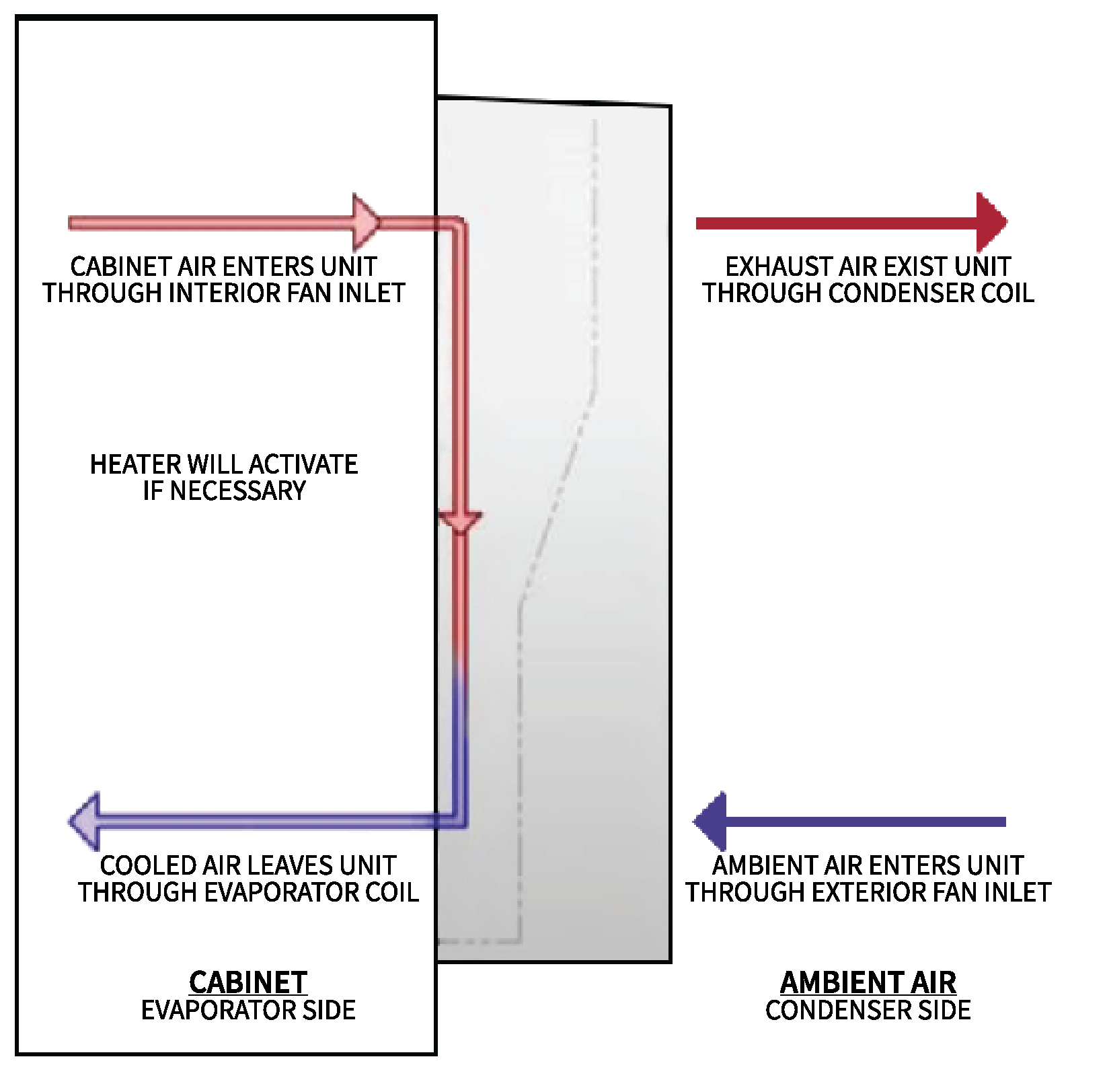 |
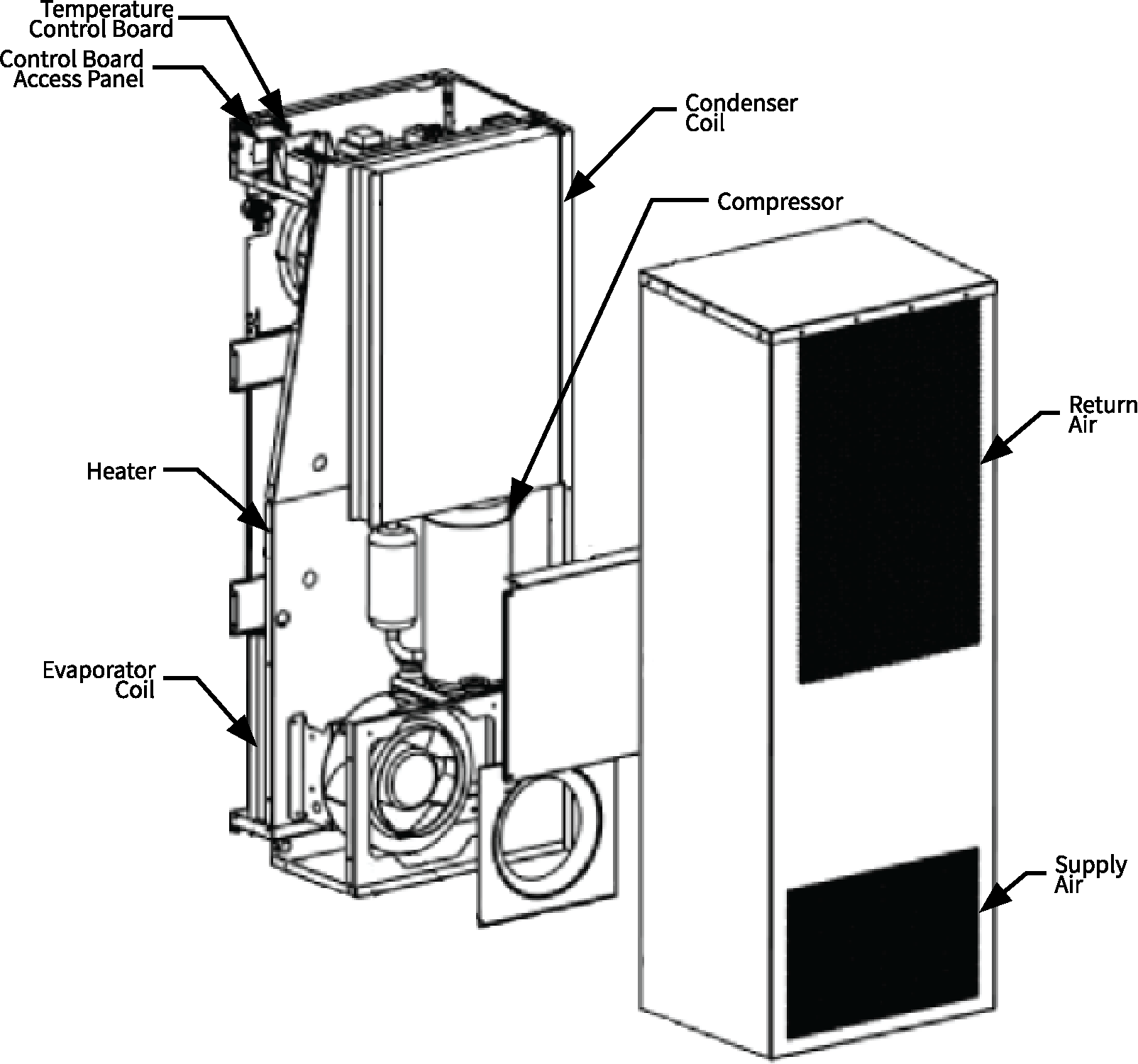 |
| Exterior air enters the unit at the bottom, side, or bottom-front and discharges air through the condenser coil at the top-front of the unit. The interior air enters through the top-back of the unit and discharges conditioned air through the evaporator coil on the bottom-back of the unit. Airflow on the interior/evaporator side can be actively heated with an electric heater. | |
| MAINTENANCE: Although the HVAC system installed in the Hybrid Cube is designed to require minimal maintenance, it is recommended that the units be inspected periodically for proper operation. The frequency of maintenance is a function of the site conditioners, such that dirtier sites may require more frequent maintenance to clean coils and/or filters. |
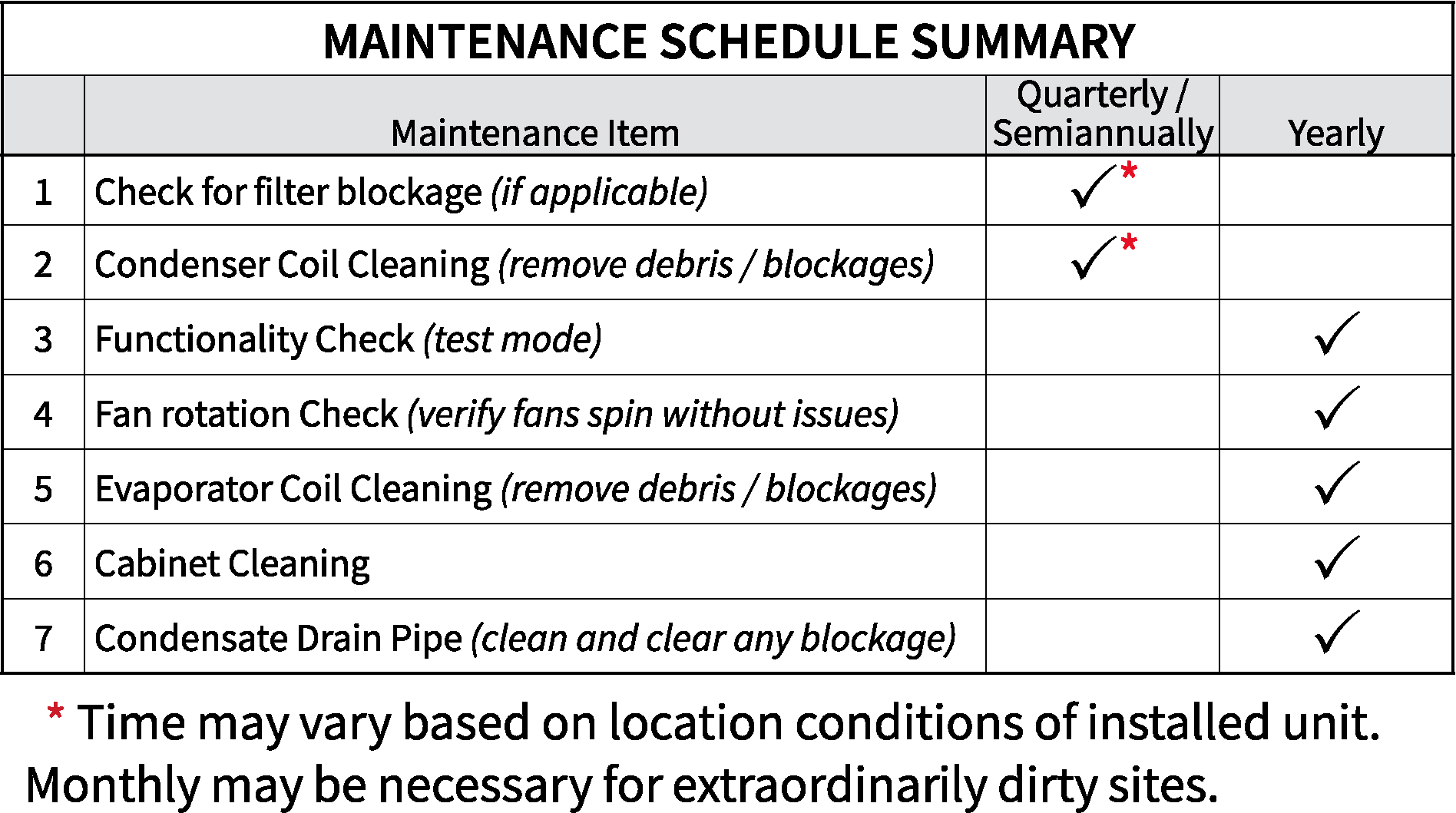 |
| The following items can be reviewed during other routine maintenance of the cabinet/equipment: | |
| - Verify operation of the interior and exterior fans. Use the control board test mode to verify operation of the compressor, heater (if applicable), and fans. - Verify that the unit is sealed properly. The field sealing of the unit to the cabinet/equipment should be inspected to ensure proper sealing. - Interior/evaporator and Exterior/condenser coil should be cleaned using a commercial available non-acidic HVAC coil cleaner. - Clean the exterior condenser filter (optional item), if applicable |
|
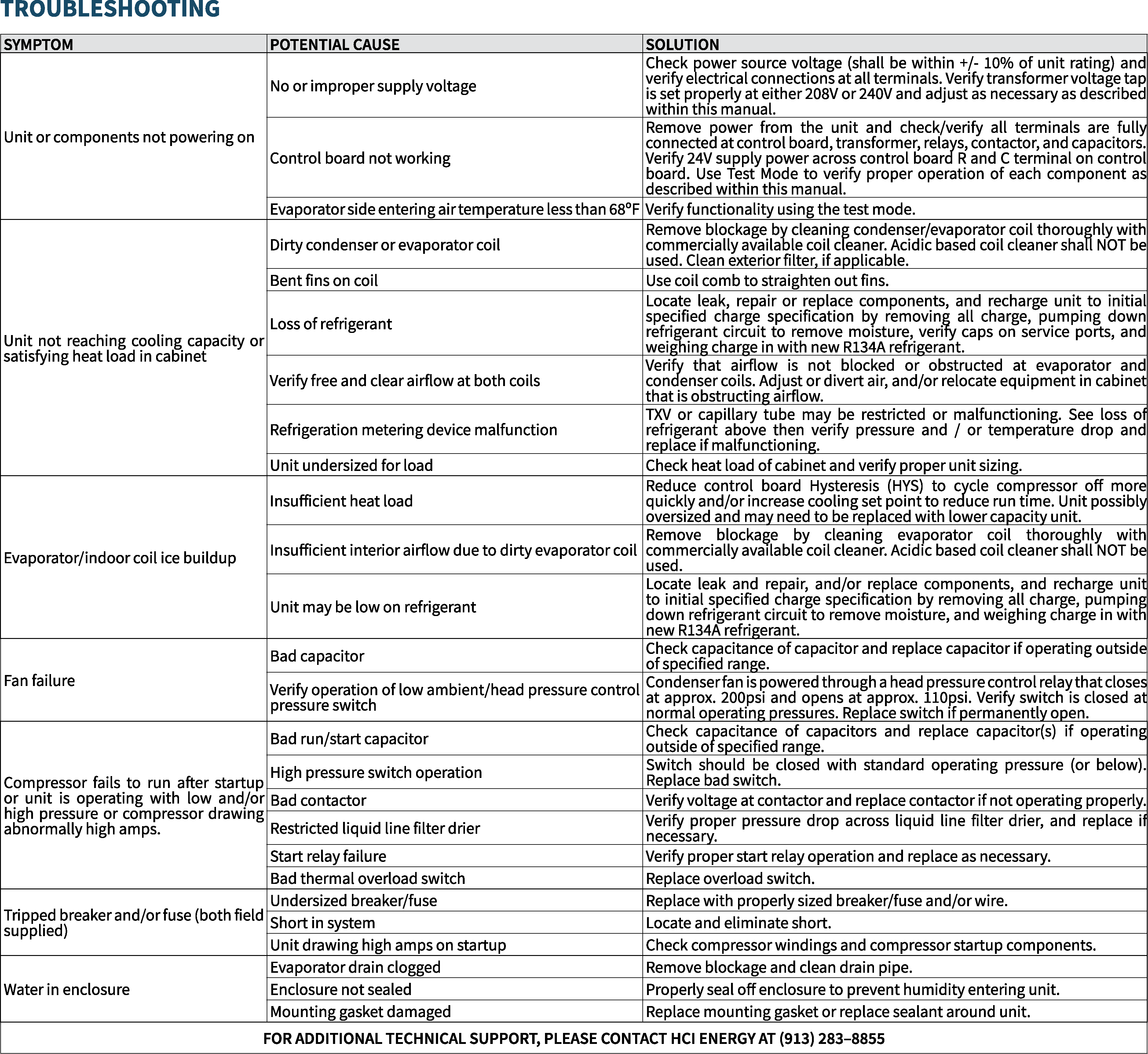 |
|
|
TEMPERATURE CONTOL BOARD:
|
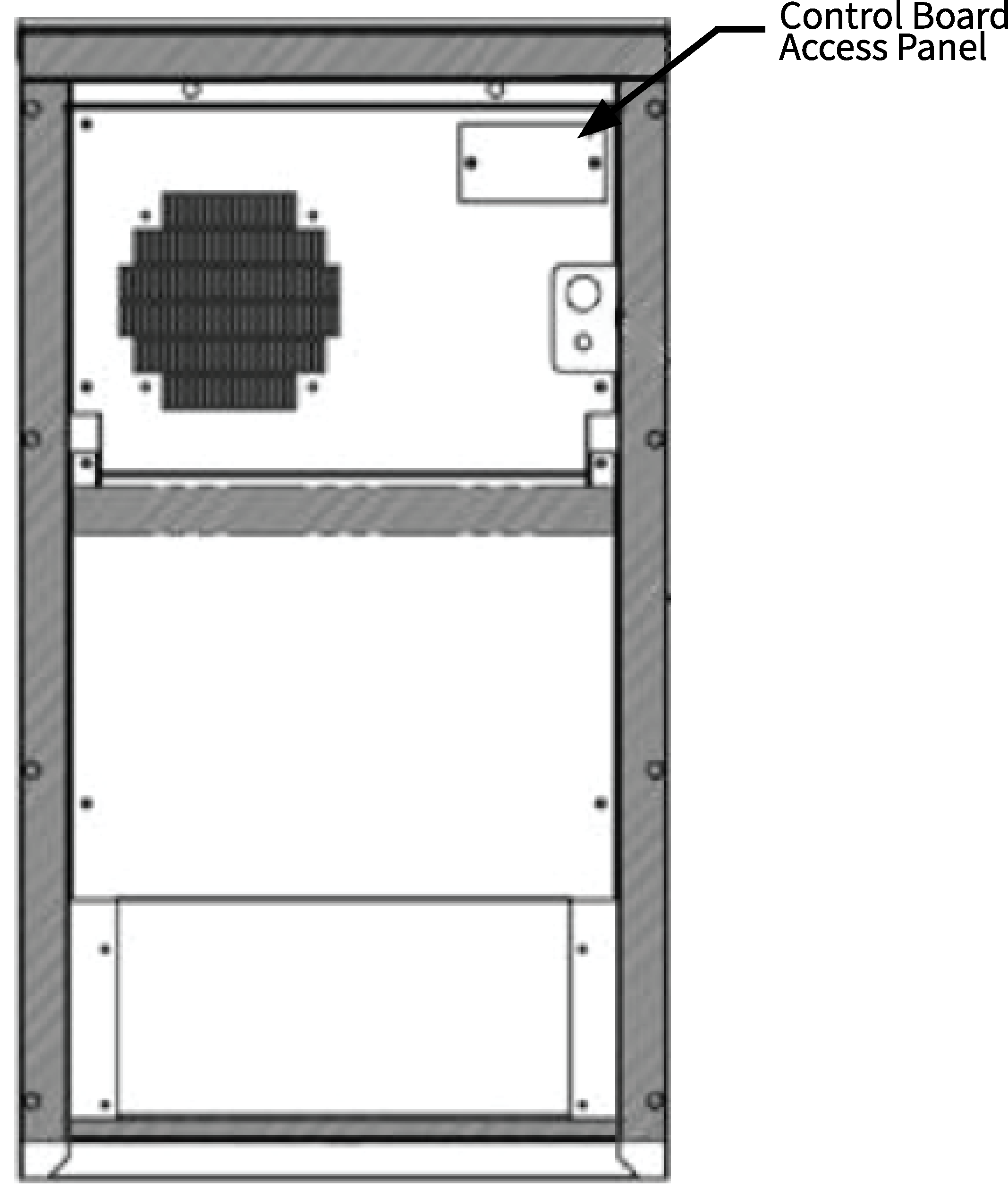 |
 |
|
| The controller provides control of cooling and heating (if the optional heater is included) with auto-change over between heating and cooling mode. The board includes adjustable DIP switches to allow user configuration of desired temperature alarming, as well as providing testing and diagnosis functions. The board monitors temperature utilizing an on-board temperature sensor and remote sensor (installed as standard option), and the board temperature display function provides for temperature sensor reading verification for diagnostic purposes. The remote temperature sensor is connected to board and located within the interior cabinet section near the interior fan. The board uses the remote temperature sensor for all operations. The on-board sensor is provided as a backup only with no effect on operation if the remote sensor is attached and functioning properly. The remote temperature sensor is installed within the interior fan section of the unit , however the remote temperature sensor includes a 6’ long lead wire and may be relocated outside of the unit, if deemed necessary by the installer or service technician. Be careful NOT to install the sensor in an area that is not properly conditioned by the unit (e.g. rear of cabinet obstructed by equipment resulting in insufficient airflow and conditioning), as that may result in the unit freezing and/or resulting in equipment damage. |
|
| In addition to monitoring temperature for alarming purposes, the controller utilizes an input from the high pressure switch. The pressure sensor is provided to prevent permanent damage of the system due to system failure or lack of maintenance, as well as to provide a trouble alarm (LED status lights and alarm output). The pressure sensor monitoring and effect on sequence of operations is further discussed on below. | |
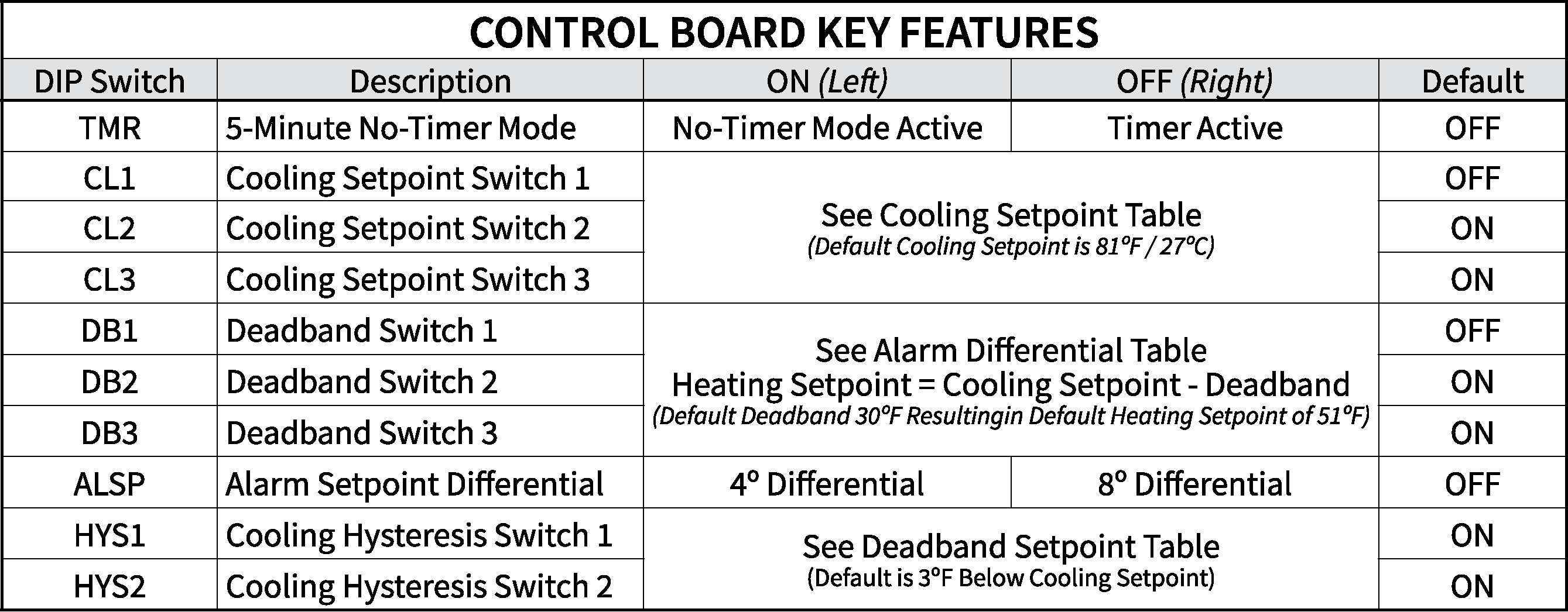 |
 |
| DIP Switch Settings: The ten (10) DIP switches allow users to configure the controller for proper temperature and alarming. DIP switches are either ON (left position) or OFF (right position), as outlined below: |
|
| No-Timer Mode: The NO-TIMER MODE allows an installer or maintenance technician to bypass all delays provided internally to the board (e.g. 5 min. anti-short cycling cooling delay). This switch may be used immediately after initial startup or cycling of power, or after the termination of a cooling or heating command. NO-TIMER MODE is active for 5 minutes after the NO-TIMER MODE is toggled from OFF to ON. During NO-TIMER MODE all timed delays will be ignored. However, to protect the compressor, a low or high pressure event will immediately terminate NO-TIMER MODE and the board will be locked out for cooling operation in order to protect the refrigeration circuit. If the NO-TIMER MODE switch is left ON and power is cycled, the board will not permit a NO-TIMER MODE until after the switch is toggled OFF and back ON. |
|
| Heating and Deadband Setpoints: Heating setpoint is set based upon the deadband DIP switch settings. Heating setpoint is equal to the cooling setpoint minus the deadband. The deadband DIP switch settings are identified below in Deadband Setpoint table. The board will energize heating operation immediately upon the temperature sensor reading a temperature 1°F below the heating setpoint (Cooling Setpoint minus Deadband), as long as the board is not in a 2 minute heating delay during initial startup or following the previous heating operation. Heating operation will stop when the temperature is 2°F above the heating setpoint. A 2 minute heating delay is active upon initial startup, power cycling, and following the termination of the previous heating operation. This delay may be temporarily bypassed, as discussed above with NO-TIMER MODE. |
|
 |
|
| Cooling Setpoint and Hysteresis: Cooling setpoint is based upon CL1/CL2/CL3 positions as shown below in Cooling Setpoint Settings table. The board will energize cooling operation immediately upon the temperature sensor reading a temperature 1°F above the cooling setpoint, as long as the board is not in a cooling delay (5 minutes). The cooling operation will terminate when the temperature sensor reads a temperature equal to the setpoint less the hysteresis, with the hysteresis settings shown below in Cooling Hysteresis table. |
|
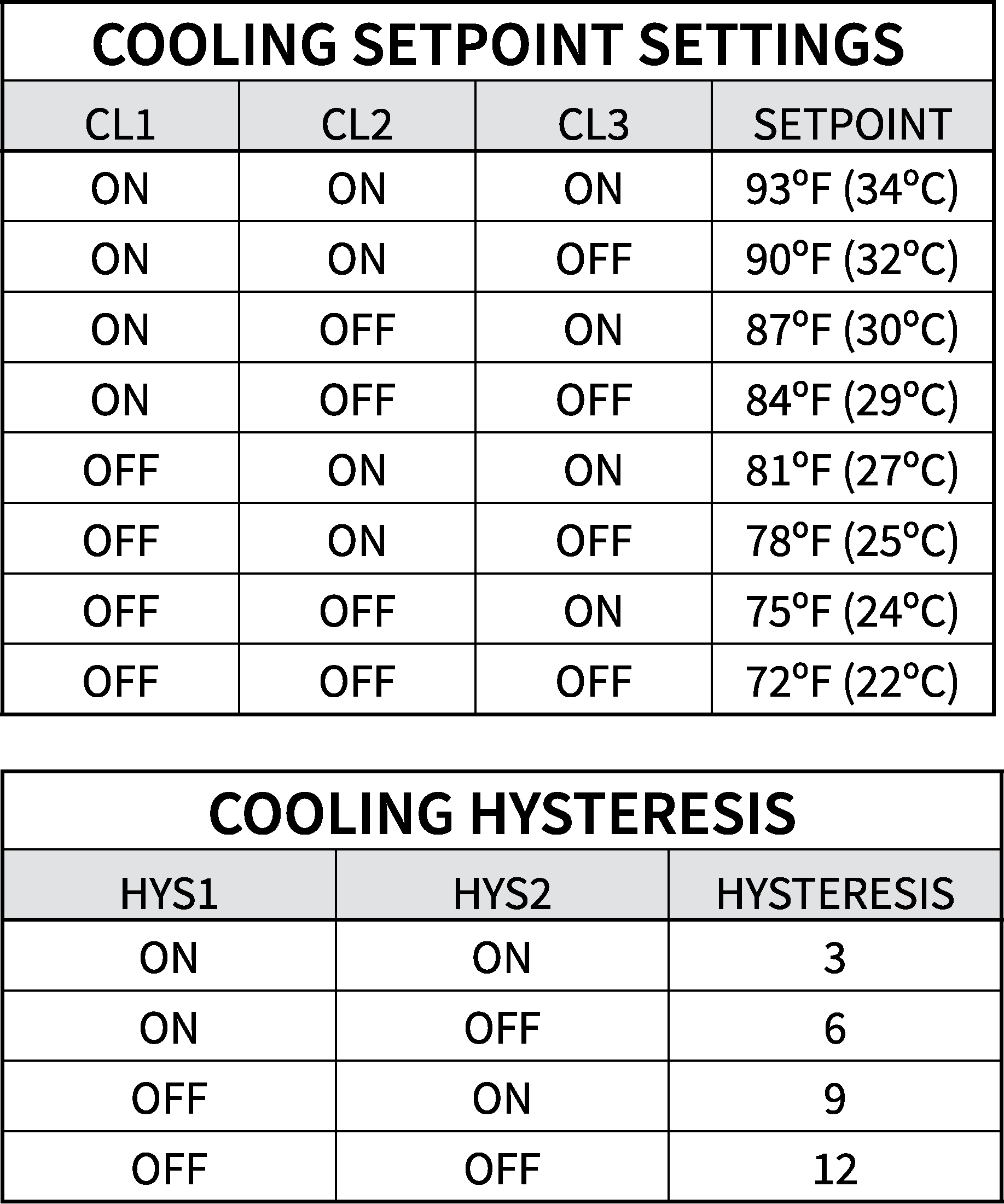 |
The hysteresis is the differential below the cooling setpoint when the unit will stop cooling operations. The Hysteresis is set per Cooling Hysteresis. As an example, if the cooling setpoint is 81°F and the Hysteresis is set to 3°F, the cooling operation will begin at 82°F (Cooling Setpoint + 1°F) and will terminate cooling operations at 78° (81°F - 3°F). The cooling delay is used to prevent short cycling, which may cause premature unit failure. The 5 minute cooling delay is active upon initial startup, power cycling, and following the termination of the previous cooling operation. This delay may be temporarily bypassed, as discussed above with NO-TIMER MODE. |
| NOTE: Initial cooling operation in no or low load conditions may result in delayed cooling. This delay while the compressor is operating may be 3-6 minutes and the condenser fan 1 may not be operating during this time due to the low ambient control/head pressure. Condenser fan 2 (if applicable) will continue to run unless the thermal switch option is installed and ambient temperature is below setpoint. |
|
| Operate with all functions for cooling and/or heating during a temperature alarm. If the temperature alarm clears, the alarm output will be deactivated and the TEMP LED will flash for a period of 100 hours. A subsequent temperature alarm, if any, will repeat the process with the same sequence. The active temperature alarm LED and alarm output may be cleared by cycling power to the unit. | |
| Temperature Alarm Setpoint and Alarm LED Light Status: The temperature alarm setpoint operates for both cooling and heating, and is based upon the alarm differential from setpoint, with DIP switch settings below in the Alarm Differential table. For cooling, this alarm setpoint is the cooling setpoint plus the alarm differential. For heating the alarm setpoint is the heating setpoint less the alarm differential. A ten (10) minute delay is used to prevent nuisance temperature alarms. If the board measures a temperature above/below the temperature alarm setpoint for 10 minutes, the board will activate the alarm output as further discussed below. |
 |
| If the user prefers continuous fan operation, the line voltage fan blue wire from the fan to the fan relay may be relocated to the continuous power side of the compressor contactor. This continuous interior fan adjustment is noted on the wiring diagram. Disconnect power to the unit prior to making this wiring change. | |
| Test Mode: The Test Mode is available to allow the installer or service technician to test operation of each component of the system. To enter test mode, press the TEST button for at least 1 second to begin the following test sequence. |
 |
| IMPORTANT NOTE: Condenser fan 1 will begin operation once the high pressure equals the +/- 200 psi cut-in pressure of the low ambient control pressure switch. Subject to testing in extreme/low temperature conditions (e.g. below 0°F) or in low or no load conditions, the outdoor condenser fan may not energize during the 60 second Cooling Operation test period. In these extreme conditions the cooling operation will need to be tested using a standard cooling operation, with the technician having available the NO-TIMER MODE to bypass the 5 minute delay. If condenser fan 2 (if applicable) is using the temperature switch, disconnect from switch and jumper the connection in order to bypass the delay. |
|
| Compressor Delay: Initial cooling operation in no or low load conditions may result in delayed cooling. This delay while the compressor is operating may be 3-6 minutes and the condenser fan may not be operating during this time due to the low ambient control/head pressure switch. Condenser fan 2 (if applicable) will run unless the thermal switch option is installed and the ambient temperature is below setpoint. |
|
